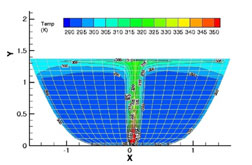NEWS RELEASES
FOR IMMEDIATE RELEASE
June 16, 2005
Sandia, FAA, NASA create computer model for fire detection in airliner cargo compartments
 Prediction of compartment temperatures by the computational model. Code predicts transport of heat, smoke, and gas species. (The X stands for width and Y stands for height of the cargo compartment).
Prediction of compartment temperatures by the computational model. Code predicts transport of heat, smoke, and gas species. (The X stands for width and Y stands for height of the cargo compartment). Download 300dpi JPEG image, “smoke.jpg,” 644K (Media are welcome to download/publish this image with related news stories.)
ALBUQUERQUE, N.M. — A project to improve the false alarm rate and to standardize the certification of fire detection systems in cargo compartments of commercial aircraft is underway with major participation by Sandia National Laboratories, the Federal Aviation Administration (FAA), and NASA Glenn Research Center. Sandia’s role in the project was to develop a physics-based Computational Fluid Dynamics (CFD) model to analyze smoke transport in cargo compartments.
The FAA and other regulatory agencies throughout the world require that cargo compartments on passenger-carrying aircraft be equipped with fire detection systems. Unfortunately, a false alarm for a cargo compartment detection system is estimated to occur 100 times more frequently than an alarm due to an actual fire source. This often results in emergency diversion landings that are costly and that may needlessly compromise the safety of the flight.
Current regulations require that the detection systems alarm within one minute of the start of a fire. Flight tests are required to certify detection systems and demonstrate compliance with these regulations. Due to the high costs of flight tests, extensive ground tests are typically conducted to ensure that the detection system will meet requirements during the flight tests.
Lou Gritzo, Sandia’s Manager of Fire Sciences, says “The overall objective was to create a model that would help minimize false alarms in cargo compartments of commercial aircraft by assisting in the design and certification of new detection systems. Current detection systems are prone to alarm from various sources such as dust and humidity and are inaccessible by crewmembers for inspection during flight.”
Gritzo says new detection systems will likely be multi-criteria detectors, which will be less prone to false alarms since they will require sensing and then comparison of two or more aspects of a fire’s signature (i.e., heat, particulate, combustion gases) before alarming.
Work on the model was primarily conducted by Sandia researcher Jill Suo-Anttila, project manager, Walt Gill and Stefan Domino, Sandia senior staff members, and Carlos Gallegos, team member.
The CFD model couples heat, mass, and momentum transfer phenomena in cargo compartment fires. The fire source term is specified in the model based on FAA measurements of the heat release rate, mass loss rate, and particulate and gas species generation rates of the newly developed standardized fire source. The model provides information on the transport of particulate and combustion gases in cargo compartments with varying fire and sensor locations, compartment geometry, ventilation, loading, compartment temperature, and compartment pressure.
Suo-Anttila says the smoke transport model has the potential to enhance the detection system design and certification process by determining worst case locations for fires, optimum placement of fire detector sensors within the cargo compartment, and sensor alarm levels needed to achieve detection within the required certification time. The model is also expected to decrease the time and cost of the certification process by reducing the total number of both in-flight and ground experiments.
The model was verified and validated using full-scale FAA experimental data. It is fast running and user-friendly to allow a large number of simulations to be run by individuals who are not CFD experts. The alpha version of the transport code was released in November 2004, and user suggestions are being collected for improvement. The next release is scheduled for later this year.
The computational model and the standardized fire source are two aspects of an overall project to standardize the requirements for cargo compartment fire detection systems and to provide guidelines for more efficient design and certification of multi-sensor systems that are less susceptible to false alarms.
Sandia is a multiprogram laboratory operated by Sandia Corporation, a Lockheed Martin company, for the U.S. Department of Energy’s National Nuclear Security Administration. Sandia has major R&D responsibilities in national security, energy and environmental technologies, and economic competitiveness.
Sandia media contact: Michael Padilla, mjpadil@sandia.gov, (505) 284-5325